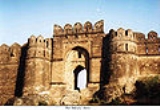
Rohtas Fort
Encyclopedia
Rohtas Fort is a garrison fort built by the great Afghan king Sher Shah Suri
. This fort is about 4 km in circumference and the first example of the successful amalgamation of Pashtun and Hindu architecture in the Indian Subcontinent
.
in Shahabad district near Baharkunda, Bihar
which he captured from the Raja of Rohtas Hari Krishan Rai in 1539. Rohtasgarh is situated on the upper course of the river Son, 20 37’ N and 85 33’E. It was built by Harish Chandra of the Solar dynasty and was named after his son Rohitasva after whom the fort (Rohtasgarh) was named.
's return to India after defeating him in the Battle of Kanauj. This fort lies on the old GT road between the North (Afghanistan) to the Plains of Punjab. It blocked the way from Peshawar to Lahore. The other reason was to suppress the local tribe of this region Potohar called Gakhars
who were allies of Humayun and refused their allegiance to Sher Shah Suri. The Emperor instructed the local Janjua Rajput
tribe to help construct the fort to crush the Gakhars when the latter became openly defiant and persecuting labourers who attended the construction.
The Fort was built by Todar Mal under orders of Sher Shah.
.
. It was constructed on a hillock where the tiny Kahan
river meets another rainy stream called Parnal Khas and turns east towards Tilla Jogian
Range. The fort is about 300 feet (91.4 m) above its surroundings. It is 2660 feet (818 m) above sea level and covers an area of 12.63 acres (51,111.8 m²).
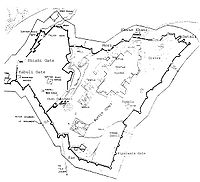 Qila Rohtas is a garrison fort and could hold a force of up to 30,000 men. Due to its location, massive walls, trap gates and 3 Baolis (stepped wells) it could withstand a major siege although it was never besieged.
Qila Rohtas is a garrison fort and could hold a force of up to 30,000 men. Due to its location, massive walls, trap gates and 3 Baolis (stepped wells) it could withstand a major siege although it was never besieged.
Most of the fort was built with ashlar
stones collected from its surrounding villages such as Tarraki village. Some parts of the fort were built with bricks.
The fort is irregular in shape and follows the contours of the hill it was constructed on. The fort is exactly 5.2 km in circumference. A 533 metre long wall divides the citadel (for the Chieftain) from other parts of the fort.
The fortification has 68 bastions (towers) at irregular intervals. Out of the 3 Baolis, one of them is in the citadel and the rest are in the other parts of the fort. One of the Gates (Langar Khani) opens into the citadel and is a trap gate because it is in the direct line of fire of the bastions.
The Khwas Khani gate is an example of double walling. A small enclave on the western side is a citadel within a citadel. It is accessible by only one gate and also had a very fine Baoli which suggests that it was meant for the Chief and his family. In this citadel there is a beautiful Mosque called the Shahi Mosque (Not to be confused with the one in Lahore). There are no palaces in the Fort except for a structure built by Raja Man Singh called the Haveli of Man Singh. It is built on the highest point of the citadel.
whose area the fort was built on refused to provide labour for this project.
Todar Mal faced with such problems informed Sher Shah about these difficulties who wrote in reply,” I know you for a man of business, understanding and intelligence. I see no work can be expected from you, because you consider money as your friend. When I have commanded you to do a thing you ought not to have cared for money in fixing the rate. Whatever be the expenses, shall be borne by my government.”
After receiving this reply, he fixed one red Ashrafi
for each slab on the first day. The rate gradually decreased to one Paoli
or Bahluli.
Because of the boycott the cost of construction was huge. It would have been much lower had it not been for the Ghakkars. The following sources all give slightly different estimates of the cost
“The amount is 16, 10, 00,000 Dams
and something more, which is 34, 25,000 Rupees of Hindustan, 120,000 Tumans
of Iran or 1,21,75,000 Khanis of Turan
”.
Choa Sahib (Sikh Shrine outside the fort).....
The choa (the fountain discovered by Guru Nanak) lies outside the fort. Shershah Suri tried to cover it for the use of water by his
military. He built the wall around it to take it inside. But every time he tried to cover, the choa miraclusly went outside the wall of the fort. He tried 7 time. Finally he gave up.(Reference??)
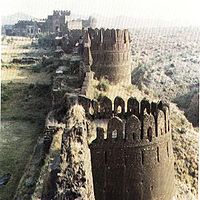 The height of the outer wall varies between 10 and 18 meters. Its thickness varies between 10 and 13 meters. The wall has 2 or 3 terraces and varies in thickness, the maximum being 13 meters near the Mori Gate. The terraces are linked by staircases. The topmost terrace has merlon-shaped battlements. Muskets can be fired from these battlements. Soldiers could also pour molten lead over the walls.
The height of the outer wall varies between 10 and 18 meters. Its thickness varies between 10 and 13 meters. The wall has 2 or 3 terraces and varies in thickness, the maximum being 13 meters near the Mori Gate. The terraces are linked by staircases. The topmost terrace has merlon-shaped battlements. Muskets can be fired from these battlements. Soldiers could also pour molten lead over the walls.
The wall is built in sandstone laid in lime mortar mixed with brick. The gates are in grey ashlar
masonry. Some portions have been built using burnt brick.
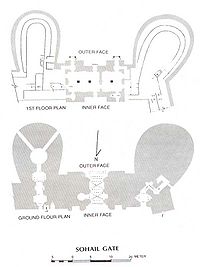 This gate is the best example of masonry in use in the time of Sher Shah. It derives its name from a Saint names Sohail Bukhari buried in the south-western bastion of the gate. Others say that it was names after the Sohail Star which rises on this side of the fort.
This gate is the best example of masonry in use in the time of Sher Shah. It derives its name from a Saint names Sohail Bukhari buried in the south-western bastion of the gate. Others say that it was names after the Sohail Star which rises on this side of the fort.
It is a double gate rectangular in shape. It is 21.34 meters (70 ft) high, 20.73 meters (68 ft) wide and 15 meters (50 ft) deep. The central archway is 4.72 meters (15 ft) wide. It has an inner and an outer arch which is decorated with beautiful and simple motifs of sunflower. This decoration is repeated in all parts of the Qila.
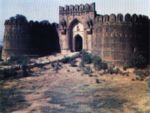 There are balconies on either side of the central arch. These balconies have a small dome and their sides and bottom are also decorated. Unlike other parts of the Qila which has been built in Afghan-Persian style, the balcony is an example of Hindu architecture. These same balconies can be seen in Haveli Man Singh. There is a small window in the middle of the outer arch. This window is different from the two balconies to either side of the outer arch. It is much simpler that these two balconies.
There are balconies on either side of the central arch. These balconies have a small dome and their sides and bottom are also decorated. Unlike other parts of the Qila which has been built in Afghan-Persian style, the balcony is an example of Hindu architecture. These same balconies can be seen in Haveli Man Singh. There is a small window in the middle of the outer arch. This window is different from the two balconies to either side of the outer arch. It is much simpler that these two balconies.
 There are seven merlons on this gate. The bastions are with battlements which have loopholes. These bastions have three levels on the inside. These can be seen if one zooms in the Sohail Gate picture.
There are seven merlons on this gate. The bastions are with battlements which have loopholes. These bastions have three levels on the inside. These can be seen if one zooms in the Sohail Gate picture.
 The inner side of the gate mirrors the outside but has less decoration. There are no battlements towards the inside and no balconies either. The rooms in the upper storey of this gate have windows that open towards the inside of the Qila. Like the outer arch there is a small window in the middle of the inner arch. The gate now houses a Visitors information center and a Museum set up by the Himalayan Wildlife Foundation.
The inner side of the gate mirrors the outside but has less decoration. There are no battlements towards the inside and no balconies either. The rooms in the upper storey of this gate have windows that open towards the inside of the Qila. Like the outer arch there is a small window in the middle of the inner arch. The gate now houses a Visitors information center and a Museum set up by the Himalayan Wildlife Foundation.
 This gate links the citadel to the main fort. It is named after a Saint Shah Chandwali who refused to get his wages for working on this gate. The saint died while still on work and was buried near the gate. His shrine still stands to this day.
This gate links the citadel to the main fort. It is named after a Saint Shah Chandwali who refused to get his wages for working on this gate. The saint died while still on work and was buried near the gate. His shrine still stands to this day.
This gate is also a double gate. The outer gate, the entrance of which is from the citadel is 13.3 meters wide and 8.23 meters deep. The inner gate is a simple archway which is 3.66 meters wide.

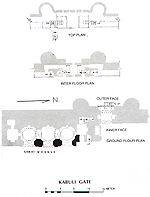 This gate opens to the west and is named “Kabuli” because it faces Kabul. It is a double gate and its opening is 3.15 meters (10 ft) wide. It has two bastions on each side. The gate has 5 battlements on top and has stairs leading up to it from the outside. On the southern side of the gate is the Shahi (Royal) Mosque because of which many people also call it Shahi (Royal) Darwaza (Gate or Door). There is a Baoli near this gate.
This gate opens to the west and is named “Kabuli” because it faces Kabul. It is a double gate and its opening is 3.15 meters (10 ft) wide. It has two bastions on each side. The gate has 5 battlements on top and has stairs leading up to it from the outside. On the southern side of the gate is the Shahi (Royal) Mosque because of which many people also call it Shahi (Royal) Darwaza (Gate or Door). There is a Baoli near this gate.

 The gate derives its name from the beautiful glazed tiles used to decorate its outer arch. These tiles are the earliest examples of this technique which was later refined in Lahore. These tiles are blue in color.
The gate derives its name from the beautiful glazed tiles used to decorate its outer arch. These tiles are the earliest examples of this technique which was later refined in Lahore. These tiles are blue in color.
An inscription on the left side of the gate gives the date of construction of the fort. The inscription is in Persian and is translated as follows
In the Hijri Year 948 came the exalted
At that time constructed the great fort
The emperor is Sher, with long life
There is no match to his good fortune
It was completed by Shahu Sultan
The Hijri year 948 is 1541 CE.
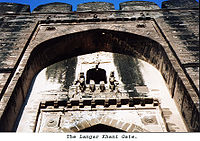
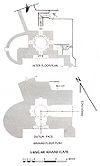 It is a double gate 15.25 meters (50 ft) high, 3.5 meters (11.5 ft) wide with a central arched opening. The oouter arch has a small window like the Sohail Gate. The outer opening leads to a Langar Khana (Mess or Canteen).
It is a double gate 15.25 meters (50 ft) high, 3.5 meters (11.5 ft) wide with a central arched opening. The oouter arch has a small window like the Sohail Gate. The outer opening leads to a Langar Khana (Mess or Canteen).
There are two bastions on either side of the gate which have kitchen, stores and a well for water. The opening of this gate is L shaped. As soon as one enters from the outer gate one has to turn right.
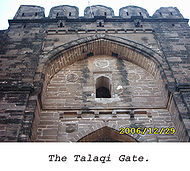
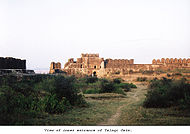 This gate is 15.25 meter high and 13.8 meter wide with two bastions on either side. This gates name derives from “Talaq” (divorce). According to a legend, Prince Sabir Suri entered the gate and had an attack of fever which proved fatal. This was regarded as a bad omen and the name became “Talaqi”.
This gate is 15.25 meter high and 13.8 meter wide with two bastions on either side. This gates name derives from “Talaq” (divorce). According to a legend, Prince Sabir Suri entered the gate and had an attack of fever which proved fatal. This was regarded as a bad omen and the name became “Talaqi”.
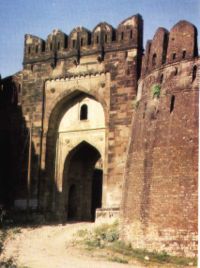 This gate is named after one of Sher Shah Suri’s greatest general, Khwas Khan. This was the original entrance to the Qila (Fort) because outside the gate lies the old GT Road.
This gate is named after one of Sher Shah Suri’s greatest general, Khwas Khan. This was the original entrance to the Qila (Fort) because outside the gate lies the old GT Road.
It is a double gate. The outer gate is 12.8 meter wide (42 ft) and 8 meter (26 ft) deep. This gate has a bastion and a defensive wall on each side. On the bastions canons could be deployed. The inner and outer gates are almost mirror images of each other. The top of the gate has five battlements. All of these have loopholes as well as machicolation. Unlike other gates of this Qila, the inner side of the gate has five battlements.
The inner and outer arches have sunflower motifs like the Sohail Gate. The gate also has a room which has windows opening to the inside and the outside.
It is pertinent to mention here that when the Gakhars refused their allegiance to Sher Shah Suri, he launched an expedition to punish them. This resulted in the capture of the Gakhar
chief Sarang Khan and his daughter. Sarang Khan was then killed. His daughter was then married to Sher Shah’s favourite general Khwas Khan.
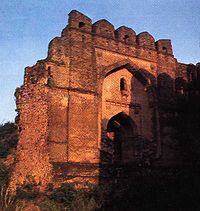 It is a single gate 9.15 meter high and 6.1 meter deep. This gate faces to the village Gatali
It is a single gate 9.15 meter high and 6.1 meter deep. This gate faces to the village Gatali
Ford
(ravine) which is called also Patan Gatiali or Gatiyalian, the important point to cross the River Jhelum for the Kashmir Vally, thus the name.
 This small mosque is near the Kabuli gate. It has a prayer chamber and a small courtyard. It is the most decorated of the original buildings of the fort. To be ever ready in case of attack, stairs lead directly from the courtyard of this mosque to the top of Kabuli Gate.
This small mosque is near the Kabuli gate. It has a prayer chamber and a small courtyard. It is the most decorated of the original buildings of the fort. To be ever ready in case of attack, stairs lead directly from the courtyard of this mosque to the top of Kabuli Gate.
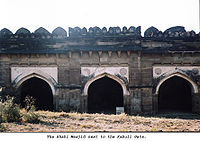 The prayer chamber is 19.2 meter long and 7.3 meter deep. It is divided into 3 equal chambers. There are domes from the inside but from the outside no domes can be seen. There is a small room at the end of these three chambers. This room was for the Pesh Imam (Prayer Leader). This room has a small domed roof from the inside but no outer dome. There is no place for ablution(cleaning up before prayers) in the mosque. This mosque is built into the fortification wall i.e. soldiers walked over the mosque's roof. The outer wall of the mosque is the fortification wall itself.
The prayer chamber is 19.2 meter long and 7.3 meter deep. It is divided into 3 equal chambers. There are domes from the inside but from the outside no domes can be seen. There is a small room at the end of these three chambers. This room was for the Pesh Imam (Prayer Leader). This room has a small domed roof from the inside but no outer dome. There is no place for ablution(cleaning up before prayers) in the mosque. This mosque is built into the fortification wall i.e. soldiers walked over the mosque's roof. The outer wall of the mosque is the fortification wall itself.
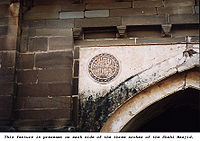 On the outer wall of the mosque are beautiful round designs in which Islamic verses are written in Naqsh script. These verses are surrounded by a Lilly going around the Naqsh script. The Lilly design was later used by Mughals in Tomb of Jahangir
On the outer wall of the mosque are beautiful round designs in which Islamic verses are written in Naqsh script. These verses are surrounded by a Lilly going around the Naqsh script. The Lilly design was later used by Mughals in Tomb of Jahangir
, Tomb of Nur Jehan
and the Shah Burj Gate in Lahore Fort
. The design seems to have been copied from the coins used in that time.
 There are 3 Baolis in the fort. These were made by cutting deep into the lime rock. They are
There are 3 Baolis in the fort. These were made by cutting deep into the lime rock. They are
 The Rani Mahal (Queens palace) is near Haveli Man Singh. It is a one storey structure. It originally had four rooms but only room remains standing today. The foundation of the four rooms can still be seen today.
The Rani Mahal (Queens palace) is near Haveli Man Singh. It is a one storey structure. It originally had four rooms but only room remains standing today. The foundation of the four rooms can still be seen today.
 It is not an original part of the fort and is an example of Hindu architecture and built around the same time as the Haveli Man Singh.
It is not an original part of the fort and is an example of Hindu architecture and built around the same time as the Haveli Man Singh.
 The room still standing today is about 20 feet (6.1 m) high and beautifully decorated on the inside and outside. The roof of the dome like room is like a flower. The inside of the roof is decorated with flowers, geometrical patterns and fake windows. The room is about 8 feet (2.4 m) by 8 feet (2.4 m).
The room still standing today is about 20 feet (6.1 m) high and beautifully decorated on the inside and outside. The roof of the dome like room is like a flower. The inside of the roof is decorated with flowers, geometrical patterns and fake windows. The room is about 8 feet (2.4 m) by 8 feet (2.4 m).
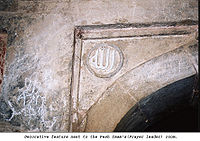
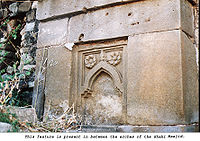 These carvings are found on the gate and in the mosque. Most of these are engravings in Arabic and sunflowers.
These carvings are found on the gate and in the mosque. Most of these are engravings in Arabic and sunflowers.
One of these carvings is inside the Shahi Mosque outside the Pesh Imam's (Prayer leaders) room. The carving is of the word "Allah" (God) in Arabic. The same carving is also done on merlons on top of Shahi Mosque.
The sunflower motif is on each sides of the arches of Shahi Mosque. It is also present in the guard post in between each gate.
script is used.
There is an inscription in Persian
on the Shishi gate which gives the date of start of construction. The same inscription is also found over the Talaqi gate.
There are other inscriptions on the Khwas Khani, Langar Khani and Gatali gate.
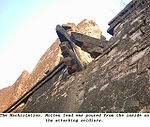 Machicolations are small drains that lead from the inside to the walls outside. They are built into the walls and are used by the soldiers on the inside to pour molten lead or other hot liquids on soldiers trying to scale the walls.
Machicolations are small drains that lead from the inside to the walls outside. They are built into the walls and are used by the soldiers on the inside to pour molten lead or other hot liquids on soldiers trying to scale the walls.
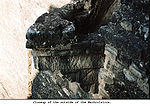 The Rohtas fort has hundreds of them and each one is beautifully decorated with geometric patterns. The pictures is of a machicolation near the Langar Khana (Mess Hall).
The Rohtas fort has hundreds of them and each one is beautifully decorated with geometric patterns. The pictures is of a machicolation near the Langar Khana (Mess Hall).
The elements of Hindu architecture are
The elements of Afghan architecture are
returned to rule India for another 15 years.
When Humayun returned the Governor of Rohtas, Tatar Khan Kasi fled. Ironically, Rohtas then became the capital of the Gakhars
, the very people it was designed to crush.
This fort was never popular with the Mughals because of its military character. Emperor Akbar stayed here for a single night. Emperor Jahangir rested here for a single night while going to Kashmir
for a rest. He said the following about its location
This fort was founded in a cleft and the strength of it cannot be imagined
Emperor Jahangir again stayed here when he was being forced to go to Kabul
by Mahabat Khan
. Nur Jahan, his beautiful and resourceful wife obtained troops from Lahore
and ordered Mahabat Khan to release her husband. Emperor Jahangir then proceeded to Rohtas and held his court here for a while. Then he went onto Kashmir and back to Lahore to die.
The later Mughals seem to have made no use of the fort. The reason is that they were allies of the Gakhars
and consequently needed no troops to maintain their hold over this area.
After the takeover of the Punjab
by the Sikhs, the Maharaja
Ranjit Singh
gave the fort to Sardar Mohar Singh who was succeeded by Gurmukh Singh. It was subsequently leased to different people and the last people to manage Rohtas was Raja Fazal Din Khan who joined Sher Singh
in rebellion.
Rohtas Fort is an outstanding example of early Muslim military architecture in the Indian subcontinent which incorporates features from elsewhere in the Islamic world. It also had a profound influence on the development of architectural styles in the Mughal Empire (and hence on the European colonial architecture that made abundant use of that tradition).
It is also outstanding by virtue of the refinement and high artistic value of its decorative elements, notably its high- and low-relief carvings, its calligraphic inscriptions in marble and sandstone, its plaster decoration, and its glazed tiles.
And
There are no surviving examples of military architecture of this period on the same scale in the sub-continent which survive to the same degree of completeness and conservation. Fatehpur Sikri (India) which is already on the World Heritage List represents the full Mughal realization of a form and style that owes everything to its precursor, Rohtas Fort.
The recommendation by ICOMOS (the organization that makes the World Heritage list) made the following recommendation
Rohtas Fort is an exceptional example of the Muslim military architecture of central and South Asia, which blends architectural and artistic traditions from Turkey and the Indian sub-continent to create the model for Mughal architecture and its subsequent refinements and adaptations.
The central archway of the Chandwali Gate has been rebuilt recently so that is the only “fake” part of the fort.
In early 2005, seepage, heavy rains, and general neglect caused the left inner face of the Talaqi Gate to collapse, and the right flank and foundation to become detached from the original structure.
The Gatali Gate forms one of the original entrances to Rohtas. Over time, its right bastion and supporting wall have collapsed as a result of permeated rainwater and the erosion of its foundations.
That this property be inscribed on the World Heritage List on the basis of criteria II and IV:
Rohtas Fort is an exceptional example of the Muslim military architecture of central and South Asia, which blends architectural and artistic traditions from Turkey and the Indian sub-continent to create the model for Mughal architecture and its subsequent refinements and adaptations.
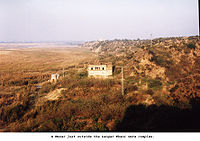 Outside the Langar Khani Gate is the tomb of a lady called Khair Un Nisa. She was the daughter of the food minister named Qadir Bukhsh. She died here and was buried in this tomb but she was later moved to Sasaram
Outside the Langar Khani Gate is the tomb of a lady called Khair Un Nisa. She was the daughter of the food minister named Qadir Bukhsh. She died here and was buried in this tomb but she was later moved to Sasaram
.
Until the construction of the new Grand Trunk Road
, Rohtas was a halting place on the main Peshawar-Lahore road. This road had serai
s about a mile apart. One of these is about one mile (1.6 km) north of the Rohtas Fort. It is in a fair state of preservation.
rohtas fort rocks
takes you past Gujar Khan and Sohawa, to the small town of Dina
130 km away. Just past Dina you will drive over a railway overpass, stay to the right of the road and take the first U-turn to drive back towards Dina. After about 100 meters to your left you will find a signpost, which indicates the way towards the road leading to Rohtas Fort which is 8 km away, past the small holy village of Muftian
home to the Mufti Tribe. Drive on the road to enter into the fort and keep driving till you reach the parking area.
, Wazirabad
and the city of Jhelum. About 10 minutes drive beyond the Jhelum bridge just short of the city of Dina, you will find a signpost to the left directing you to Rohtas Fort.
36.333333, 74.666667
UTM 43S 470084 4020973
Zoom 6 Scale ± 1:100000
Region PK Type city
Title Karimabad (Hunza) (Edit | Report inaccuracies)
Contents: Global and local systems · Wikipedia articles · Photos · Other · Export
View the location above by selecting a mapping provider:
Sher Shah Suri
Sher Shah Suri , birth name Farid Khan, also known as Sher Khan , was the founder of the short-lived Sur Empire in northern India, with its capital at Delhi, before its demise in the hands of the resurgent Mughal Empire...
. This fort is about 4 km in circumference and the first example of the successful amalgamation of Pashtun and Hindu architecture in the Indian Subcontinent
Indian subcontinent
The Indian subcontinent, also Indian Subcontinent, Indo-Pak Subcontinent or South Asian Subcontinent is a region of the Asian continent on the Indian tectonic plate from the Hindu Kush or Hindu Koh, Himalayas and including the Kuen Lun and Karakoram ranges, forming a land mass which extends...
.
Name of fort
Sher Shah Suri named Qila Rohtas after the famous Rohtasgarh FortRohtasgarh Fort
The Rohtas Fort is one of the most ancient forts of India located in a small town of Rohtas in Bihar. The culture of the Sone Valley is best symbolized by the Rohtas Fort which is a testimony of strength and power. Sadly, the majestic fort lies in utter state of ruins reminiscent of its great past,...
in Shahabad district near Baharkunda, Bihar
Bihar
Bihar is a state in eastern India. It is the 12th largest state in terms of geographical size at and 3rd largest by population. Almost 58% of Biharis are below the age of 25, which is the highest proportion in India....
which he captured from the Raja of Rohtas Hari Krishan Rai in 1539. Rohtasgarh is situated on the upper course of the river Son, 20 37’ N and 85 33’E. It was built by Harish Chandra of the Solar dynasty and was named after his son Rohitasva after whom the fort (Rohtasgarh) was named.
Reasons of construction
Sher Shah constructed Qila Rohtas to block Emperor HumayunHumayun
Nasir ud-din Muhammad Humayun was the second Mughal Emperor who ruled present day Afghanistan, Pakistan, and parts of northern India from 1530–1540 and again from 1555–1556. Like his father, Babur, he lost his kingdom early, but with Persian aid, he eventually regained an even larger one...
's return to India after defeating him in the Battle of Kanauj. This fort lies on the old GT road between the North (Afghanistan) to the Plains of Punjab. It blocked the way from Peshawar to Lahore. The other reason was to suppress the local tribe of this region Potohar called Gakhars
Gakhars
The Gakhars are an ancient warrior clan who have predominantly resided in what is present day northern Punjab and South-Western Kashmir, Pakistan. In particular in the cities of Rawalpindi, Jhelum and regions of Gilgit, Baltistan, Chitral, Khanpur and Mirpur, Pakistan...
who were allies of Humayun and refused their allegiance to Sher Shah Suri. The Emperor instructed the local Janjua Rajput
Janjua rajput
The Janjua is a Rajput royal warrior clan of South Asia and rulling warriors. They have been referred to as "the most valiant warriors of Punjab." Their warlike nature and dominant rule of their kingdoms against other tribes earned them a powerful reputation in Western Punjab, Afghanistan,...
tribe to help construct the fort to crush the Gakhars when the latter became openly defiant and persecuting labourers who attended the construction.
The Fort was built by Todar Mal under orders of Sher Shah.
.
Location
Qila Rohtas is situated in a gorge approximately 16 km NW of Jhelum and 7 km from DinaDina City
Dina is a rapidly expanding commercial town in the Jhelum District of the province of Punjab, Pakistan. It is about northwest of Jhelum City, where there is a junction with the road to the Mangla Dam and Rohtas Fort. The historic Grand Trunk Road passes through the centre of the town...
. It was constructed on a hillock where the tiny Kahan
Kahan
Kahan is located in Kohlu District of Balochistan, Pakistan. Kahan is famous for being the native village of Nawab Khair Baksh Marri, the Nawab of Kohlu Agency...
river meets another rainy stream called Parnal Khas and turns east towards Tilla Jogian
Tilla Jogian
Tilla Jogian is the highest peak in the Eastern Salt Range in Punjab, Pakistan. At 975 meters above sea level, it is about 25 km to the west of Jhelum city and 10 km west of the model village of Khukha. The view from the top of Tilla is highly rewarding...
Range. The fort is about 300 feet (91.4 m) above its surroundings. It is 2660 feet (818 m) above sea level and covers an area of 12.63 acres (51,111.8 m²).
Overview of construction

Most of the fort was built with ashlar
Ashlar
Ashlar is prepared stone work of any type of stone. Masonry using such stones laid in parallel courses is known as ashlar masonry, whereas masonry using irregularly shaped stones is known as rubble masonry. Ashlar blocks are rectangular cuboid blocks that are masonry sculpted to have square edges...
stones collected from its surrounding villages such as Tarraki village. Some parts of the fort were built with bricks.
The fort is irregular in shape and follows the contours of the hill it was constructed on. The fort is exactly 5.2 km in circumference. A 533 metre long wall divides the citadel (for the Chieftain) from other parts of the fort.
The fortification has 68 bastions (towers) at irregular intervals. Out of the 3 Baolis, one of them is in the citadel and the rest are in the other parts of the fort. One of the Gates (Langar Khani) opens into the citadel and is a trap gate because it is in the direct line of fire of the bastions.
The Khwas Khani gate is an example of double walling. A small enclave on the western side is a citadel within a citadel. It is accessible by only one gate and also had a very fine Baoli which suggests that it was meant for the Chief and his family. In this citadel there is a beautiful Mosque called the Shahi Mosque (Not to be confused with the one in Lahore). There are no palaces in the Fort except for a structure built by Raja Man Singh called the Haveli of Man Singh. It is built on the highest point of the citadel.
Cost of construction
The work on this fort was started in 1541 with Todar Mal Khatri, the revenue minister in charge of the project. The GakharsGakhars
The Gakhars are an ancient warrior clan who have predominantly resided in what is present day northern Punjab and South-Western Kashmir, Pakistan. In particular in the cities of Rawalpindi, Jhelum and regions of Gilgit, Baltistan, Chitral, Khanpur and Mirpur, Pakistan...
whose area the fort was built on refused to provide labour for this project.
Todar Mal faced with such problems informed Sher Shah about these difficulties who wrote in reply,” I know you for a man of business, understanding and intelligence. I see no work can be expected from you, because you consider money as your friend. When I have commanded you to do a thing you ought not to have cared for money in fixing the rate. Whatever be the expenses, shall be borne by my government.”
After receiving this reply, he fixed one red Ashrafi
Ashrafi
Ashrafi was gold coin issued by Muslim dynasties in Middle East, Central Asia and South Asia.- External links :* ] ]...
for each slab on the first day. The rate gradually decreased to one Paoli
Paoli
Paoli may refer to:People:*Amalia Paoli , Puerto Rican soprano, sister of the better known Antonio Paoli*Ambrose De Paoli , Roman Catholic cleric and Papal Nuncio*Angelo Paoli , Italian Carmelite...
or Bahluli.
Because of the boycott the cost of construction was huge. It would have been much lower had it not been for the Ghakkars. The following sources all give slightly different estimates of the cost
- Waqiat-i-Jahangiri says the cost was Rs. 34,25,000. It refers to an engraved stone over the Shishi Gate which reads
“The amount is 16, 10, 00,000 Dams
Dam (coin)
This article is about coinage. For other uses, see Dam .A Dam was a small Indian copper coin. The coin was first introduced by Sher Shah Suri during his rule of India between 1540 and 1545, along with Mohur, the gold coin and Rupiya the silver coin Later on, the Mughal Emperors standardised the...
and something more, which is 34, 25,000 Rupees of Hindustan, 120,000 Tumans
Iranian toman
The toman , is a superunit of the official currency of Iran, the rial. Toman, derived from a Mongolian word meaning ten thousand , was the currency of Iran until 1932. It was divided into 10,000 dinar. Between 1798 and 1825, the toman was also subdivided into 8 rial, each of 1250 dinar...
of Iran or 1,21,75,000 Khanis of Turan
Turan
Tūrān is the Persian name for Central Asia, literally meaning "the land of the Tur". As described below, the original Turanians are an Iranian tribe of the Avestan age. As a people the "Turanian" are one of the two Iranian peoples both descending from the Persian Fereydun but with different...
”.
- According to Tarikh-i-Daudi, its cost is 80,505,002 Dams (Bahlulis).
Choa Sahib (Sikh Shrine outside the fort).....
The choa (the fountain discovered by Guru Nanak) lies outside the fort. Shershah Suri tried to cover it for the use of water by his
military. He built the wall around it to take it inside. But every time he tried to cover, the choa miraclusly went outside the wall of the fort. He tried 7 time. Finally he gave up.(Reference??)
Fortification wall

The wall is built in sandstone laid in lime mortar mixed with brick. The gates are in grey ashlar
Ashlar
Ashlar is prepared stone work of any type of stone. Masonry using such stones laid in parallel courses is known as ashlar masonry, whereas masonry using irregularly shaped stones is known as rubble masonry. Ashlar blocks are rectangular cuboid blocks that are masonry sculpted to have square edges...
masonry. Some portions have been built using burnt brick.
Sohail Gate

It is a double gate rectangular in shape. It is 21.34 meters (70 ft) high, 20.73 meters (68 ft) wide and 15 meters (50 ft) deep. The central archway is 4.72 meters (15 ft) wide. It has an inner and an outer arch which is decorated with beautiful and simple motifs of sunflower. This decoration is repeated in all parts of the Qila.



Shah Chandwali Gate

This gate is also a double gate. The outer gate, the entrance of which is from the citadel is 13.3 meters wide and 8.23 meters deep. The inner gate is a simple archway which is 3.66 meters wide.
Kabuli Gate


Shishi Gate


An inscription on the left side of the gate gives the date of construction of the fort. The inscription is in Persian and is translated as follows
In the Hijri Year 948 came the exalted
At that time constructed the great fort
The emperor is Sher, with long life
There is no match to his good fortune
It was completed by Shahu Sultan
The Hijri year 948 is 1541 CE.
Langar Khani Gate


There are two bastions on either side of the gate which have kitchen, stores and a well for water. The opening of this gate is L shaped. As soon as one enters from the outer gate one has to turn right.
Talaqi Gate


Mori or Kashmiri Gate
The gate opens to the north and faces Kashmir. This gate opens into one chamber which opens into another.Khwas Khani Gate

It is a double gate. The outer gate is 12.8 meter wide (42 ft) and 8 meter (26 ft) deep. This gate has a bastion and a defensive wall on each side. On the bastions canons could be deployed. The inner and outer gates are almost mirror images of each other. The top of the gate has five battlements. All of these have loopholes as well as machicolation. Unlike other gates of this Qila, the inner side of the gate has five battlements.
The inner and outer arches have sunflower motifs like the Sohail Gate. The gate also has a room which has windows opening to the inside and the outside.
It is pertinent to mention here that when the Gakhars refused their allegiance to Sher Shah Suri, he launched an expedition to punish them. This resulted in the capture of the Gakhar
Gakhars
The Gakhars are an ancient warrior clan who have predominantly resided in what is present day northern Punjab and South-Western Kashmir, Pakistan. In particular in the cities of Rawalpindi, Jhelum and regions of Gilgit, Baltistan, Chitral, Khanpur and Mirpur, Pakistan...
chief Sarang Khan and his daughter. Sarang Khan was then killed. His daughter was then married to Sher Shah’s favourite general Khwas Khan.
Gatali Gate

Gatiali
Gatiali is a village in Jhelum District, Punjab, Pakistan. is north of Jhelum City and South of Mangla Dam....
Ford
Ford (crossing)
A ford is a shallow place with good footing where a river or stream may be crossed by wading or in a vehicle. A ford is mostly a natural phenomenon, in contrast to a low water crossing, which is an artificial bridge that allows crossing a river or stream when water is low.The names of many towns...
(ravine) which is called also Patan Gatiali or Gatiyalian, the important point to cross the River Jhelum for the Kashmir Vally, thus the name.
Tulla Mori Gate
This is an entrance rather than a gate. It is on the eastern side of the fort. It is about 2 meters wide. There is a bastion next to this entrance.Sar Gate
This is a small entrance. There is a bastion next to this gate. There is a Baoli next to this gate. It is called “Sar” because “Sar” means water.Shahi Mosque



Tomb of Jahangir
Tomb of Jahangir, is the mausoleum built for the Mughal Emperor Jahangir who ruled from 1605 to 1627. The mausoleum is located near the town of Shahdara Bagh in Lahore, Pakistan. His son Shah Jahan built the mausoleum 10 years after his father's death. It is sited in an attractive walled garden....
, Tomb of Nur Jehan
Nur Jehan
Begum Nur Jahan , also known as Mehr-un-Nisaa, was an Empress of the Mughal Dynasty that ruled much of the Indian subcontinent...
and the Shah Burj Gate in Lahore Fort
Lahore Fort
The Lahore Fort, locally referred to as Shahi Qila is citadel of the city of Lahore, Punjab, Pakistan. It is located in the northwestern corner of the Walled City of Lahore...
. The design seems to have been copied from the coins used in that time.
Baolis

The Main Baoli
It is in the middle of the Fort for soldiers, elephants, horses etc. This Baoli has 148 steps. Each step is 20 cm (8 inches) wide. The upper portion has been cut in stone. It has three arches that span the length of the baoli.The Shahi Baoli
It is near the Kabuli Gate for the Royal family. It has 60 steps and has small chambers that were used as baths by the Royal family.Rani Mahal



Decorative features
This fort is an example of purely “Masculine” architecture. It places function over form. This can be gauged from the fact that the fort originally had no permanent building for living.Stone carvings


One of these carvings is inside the Shahi Mosque outside the Pesh Imam's (Prayer leaders) room. The carving is of the word "Allah" (God) in Arabic. The same carving is also done on merlons on top of Shahi Mosque.
The sunflower motif is on each sides of the arches of Shahi Mosque. It is also present in the guard post in between each gate.
Calligraphic inscriptions
Most of these inscriptions are on the Shahi Mosque. On the outer wall of the mosque the “Kalima” is written in beautiful calligraphy on both sides of each arch of the Shahi Mosque. The NaskhNaskh (script)
Naskh is a specific calligraphic style for writing in the Arabic alphabet, thought to be invented by the Iranian calligrapher Ibn Muqlah Shirazi . The root of this Arabic term means "to copy". It either refers to the fact that it replaced its predecessor, Kufic script, or that this style allows...
script is used.
There is an inscription in Persian
Persian language
Persian is an Iranian language within the Indo-Iranian branch of the Indo-European languages. It is primarily spoken in Iran, Afghanistan, Tajikistan and countries which historically came under Persian influence...
on the Shishi gate which gives the date of start of construction. The same inscription is also found over the Talaqi gate.
There are other inscriptions on the Khwas Khani, Langar Khani and Gatali gate.
Glazed tiles
These tiles are found on Shishi gate. This type of tile became extremely popular with the Mughals who further refined them. The tiles on Shishi gate are the earliest example of the usage of these tiles. These tiles were made in Lahore.Machicolations


Architectural style
This fort was built in the Afghan-Persian architectural style. Afghans and Persians Kings had been coming to the Indian subcontinent for at least 5 centuries before the construction of this fort. Before the construction of this fort, the combination of these styles had not been harmonious. Qila Rohtas is the earliest example of the successful mixing of these two styles with the Afghan style being more prominent.The elements of Hindu architecture are
- Balconies on Sohail Gate.
- Decorations on Shahi Mosque derived from Hindu architecture.
- Haveli Man Singh (Pure Hindu architecture)
The elements of Afghan architecture are
- Utilitarian construction.
- Use of stone instead of bricks in building wall.
- No living quarters.
- Comparatively less decoration
Usage
Sher Shah Suri died before the completion of this magnificent structure. Ten years after Sher Shah’s death and the end of the Suri dynasty, Emperor HumayunHumayun
Nasir ud-din Muhammad Humayun was the second Mughal Emperor who ruled present day Afghanistan, Pakistan, and parts of northern India from 1530–1540 and again from 1555–1556. Like his father, Babur, he lost his kingdom early, but with Persian aid, he eventually regained an even larger one...
returned to rule India for another 15 years.
When Humayun returned the Governor of Rohtas, Tatar Khan Kasi fled. Ironically, Rohtas then became the capital of the Gakhars
Gakhars
The Gakhars are an ancient warrior clan who have predominantly resided in what is present day northern Punjab and South-Western Kashmir, Pakistan. In particular in the cities of Rawalpindi, Jhelum and regions of Gilgit, Baltistan, Chitral, Khanpur and Mirpur, Pakistan...
, the very people it was designed to crush.
This fort was never popular with the Mughals because of its military character. Emperor Akbar stayed here for a single night. Emperor Jahangir rested here for a single night while going to Kashmir
Kashmir
Kashmir is the northwestern region of the Indian subcontinent. Until the mid-19th century, the term Kashmir geographically denoted only the valley between the Great Himalayas and the Pir Panjal mountain range...
for a rest. He said the following about its location
This fort was founded in a cleft and the strength of it cannot be imagined
Emperor Jahangir again stayed here when he was being forced to go to Kabul
Kabul
Kabul , spelt Caubul in some classic literatures, is the capital and largest city of Afghanistan. It is also the capital of the Kabul Province, located in the eastern section of Afghanistan...
by Mahabat Khan
Mahabat Khan
Mahabat Khan , was a prominent Mughal general and statesman, perhaps best known for his coup against the Mughal Emperor Jahangir in 1626....
. Nur Jahan, his beautiful and resourceful wife obtained troops from Lahore
Lahore
Lahore is the capital of the Pakistani province of Punjab and the second largest city in the country. With a rich and fabulous history dating back to over a thousand years ago, Lahore is no doubt Pakistan's cultural capital. One of the most densely populated cities in the world, Lahore remains a...
and ordered Mahabat Khan to release her husband. Emperor Jahangir then proceeded to Rohtas and held his court here for a while. Then he went onto Kashmir and back to Lahore to die.
The later Mughals seem to have made no use of the fort. The reason is that they were allies of the Gakhars
Gakhars
The Gakhars are an ancient warrior clan who have predominantly resided in what is present day northern Punjab and South-Western Kashmir, Pakistan. In particular in the cities of Rawalpindi, Jhelum and regions of Gilgit, Baltistan, Chitral, Khanpur and Mirpur, Pakistan...
and consequently needed no troops to maintain their hold over this area.
After the takeover of the Punjab
Punjab region
The Punjab , also spelled Panjab |water]]s"), is a geographical region straddling the border between Pakistan and India which includes Punjab province in Pakistan and the states of the Punjab, Haryana, Himachal Pradesh, Chandigarh and some northern parts of the National Capital Territory of Delhi...
by the Sikhs, the Maharaja
Maharaja
Mahārāja is a Sanskrit title for a "great king" or "high king". The female equivalent title Maharani denotes either the wife of a Maharaja or, in states where that was customary, a woman ruling in her own right. The widow of a Maharaja is known as a Rajamata...
Ranjit Singh
Ranjit Singh
Maharaja Ranjit Singh Ji was the first Maharaja of the Sikh Empire.-Early life:...
gave the fort to Sardar Mohar Singh who was succeeded by Gurmukh Singh. It was subsequently leased to different people and the last people to manage Rohtas was Raja Fazal Din Khan who joined Sher Singh
Sher Singh
Maharaja Sher Singh was a Sikh ruler of the sovereign country of Punjab and the Sikh Empire. He was the son of Maharaja Ranjit Singh and Queen Rani Mehtab Kaur who was also the mother of Prince Tara Singh...
in rebellion.
Architectural legacy
Here is what the World Heritage list (Document 586) says on page 2 of the report (see references)Rohtas Fort is an outstanding example of early Muslim military architecture in the Indian subcontinent which incorporates features from elsewhere in the Islamic world. It also had a profound influence on the development of architectural styles in the Mughal Empire (and hence on the European colonial architecture that made abundant use of that tradition).
It is also outstanding by virtue of the refinement and high artistic value of its decorative elements, notably its high- and low-relief carvings, its calligraphic inscriptions in marble and sandstone, its plaster decoration, and its glazed tiles.
And
There are no surviving examples of military architecture of this period on the same scale in the sub-continent which survive to the same degree of completeness and conservation. Fatehpur Sikri (India) which is already on the World Heritage List represents the full Mughal realization of a form and style that owes everything to its precursor, Rohtas Fort.
The recommendation by ICOMOS (the organization that makes the World Heritage list) made the following recommendation
Rohtas Fort is an exceptional example of the Muslim military architecture of central and South Asia, which blends architectural and artistic traditions from Turkey and the Indian sub-continent to create the model for Mughal architecture and its subsequent refinements and adaptations.
Present state
Most of the fort is in a very good state of preservation. In the portions that have fallen away (Haveli Man Singh) one can still see some part of the original construction.The central archway of the Chandwali Gate has been rebuilt recently so that is the only “fake” part of the fort.
In early 2005, seepage, heavy rains, and general neglect caused the left inner face of the Talaqi Gate to collapse, and the right flank and foundation to become detached from the original structure.
The Gatali Gate forms one of the original entrances to Rohtas. Over time, its right bastion and supporting wall have collapsed as a result of permeated rainwater and the erosion of its foundations.
World Heritage Site
Qila Rohtas was designated a World Heritage Site in 1997. Here is what the World Heritage list (Document 586) says on page 3 of the report (see references)That this property be inscribed on the World Heritage List on the basis of criteria II and IV:
Rohtas Fort is an exceptional example of the Muslim military architecture of central and South Asia, which blends architectural and artistic traditions from Turkey and the Indian sub-continent to create the model for Mughal architecture and its subsequent refinements and adaptations.
Himalayan Wildlife Foundation
The Rohtas Fort Conservation Programme was conceived by the Himalayan Wildlife Foundation in 2000 to help protect the sixteenth-century Rohtas Fort near Jhelum, and develop it as a heritage site conforming to international standards of conservation and tourism. It is undertaking the following projects in conjunction with the Royal Norwegian Embassy.- Complete restoration of Shah Chandwali Gate
- Conservation of Haveli Man Singh
- Conservation of Talaqi Gate and Gatali Gate
- Establishment of Sher Shah Suri Museum in upper storey of Sohail Gate
- Improvement of quality of life in Rohtas Fort village
Nearby places of historical significance

Sasaram
Sasaram , sometimes also spelled as Sahasram, is the administrative headquarters of the Rohtas district in the Indian state of Bihar.It is one of the oldest cities in India, and is famous for production of stone chips and for the local quarrying industry...
.
Until the construction of the new Grand Trunk Road
Grand Trunk Road
The Grand Trunk Road also formerly known as Uttarapatha, Shah Rah-e-Azam or Sadak-e-Azam or Badshahi Sadak is one of South Asia's oldest and longest major roads...
, Rohtas was a halting place on the main Peshawar-Lahore road. This road had serai
Caravanserai
A caravanserai, or khan, also known as caravansary, caravansera, or caravansara in English was a roadside inn where travelers could rest and recover from the day's journey...
s about a mile apart. One of these is about one mile (1.6 km) north of the Rohtas Fort. It is in a fair state of preservation.
rohtas fort rocks
From Islamabad
The dual-carriage Grand Trunk RoadGrand Trunk Road
The Grand Trunk Road also formerly known as Uttarapatha, Shah Rah-e-Azam or Sadak-e-Azam or Badshahi Sadak is one of South Asia's oldest and longest major roads...
takes you past Gujar Khan and Sohawa, to the small town of Dina
Dina City
Dina is a rapidly expanding commercial town in the Jhelum District of the province of Punjab, Pakistan. It is about northwest of Jhelum City, where there is a junction with the road to the Mangla Dam and Rohtas Fort. The historic Grand Trunk Road passes through the centre of the town...
130 km away. Just past Dina you will drive over a railway overpass, stay to the right of the road and take the first U-turn to drive back towards Dina. After about 100 meters to your left you will find a signpost, which indicates the way towards the road leading to Rohtas Fort which is 8 km away, past the small holy village of Muftian
Muftian
Muftian is a village situated in Tehsil Dina Jhelum District, Punjab, Pakistan.Muftian is located close to the passing Grand Trunk Road, and around the historic Rohtas Road, which is the long used route to the famous Rohtas Fort. Muftian is a farming village and it borders Dina and is historically...
home to the Mufti Tribe. Drive on the road to enter into the fort and keep driving till you reach the parking area.
From Lahore
Drive on G.T road past GujranwalaGujranwala
Gujranwala is a industrial city in the north-east of the Punjab province. It is the sixth largest city in Pakistan with a population of approximately 2,661,360 as on 24 June 2011...
, Wazirabad
Wazirabad
AYAZ KHANWazirabad is an industrial city located in Gujranwala District, Punjab, Pakistan. Wazirabad is situated on the banks of the Chenab River nearly 100 kilometres north of Lahore on the Grand Trunk Road. It is 45 kilometres from Sialkot, 30 kilometres from the district capital - Gujranwala...
and the city of Jhelum. About 10 minutes drive beyond the Jhelum bridge just short of the city of Dina, you will find a signpost to the left directing you to Rohtas Fort.
Gallery
WGS84 36° 20′ 0″ N, 74° 40′ 0″ E36.333333, 74.666667
UTM 43S 470084 4020973
Zoom 6 Scale ± 1:100000
Region PK Type city
Title Karimabad (Hunza) (Edit | Report inaccuracies)
Contents: Global and local systems · Wikipedia articles · Photos · Other · Export
View the location above by selecting a mapping provider:
See also
- Rohtasgarh FortRohtasgarh FortThe Rohtas Fort is one of the most ancient forts of India located in a small town of Rohtas in Bihar. The culture of the Sone Valley is best symbolized by the Rohtas Fort which is a testimony of strength and power. Sadly, the majestic fort lies in utter state of ruins reminiscent of its great past,...
- Lahore FortLahore FortThe Lahore Fort, locally referred to as Shahi Qila is citadel of the city of Lahore, Punjab, Pakistan. It is located in the northwestern corner of the Walled City of Lahore...
- Derawar FortDerawar fortDerawar Fort is a large square fortress in Pakistan near Bahawalpur. The forty bastions of Derawar are visible for many miles in Cholistan Desert. The walls have a circumference of 1500 metres and stand up to thirty metres high....
- Grand Trunk RoadGrand Trunk RoadThe Grand Trunk Road also formerly known as Uttarapatha, Shah Rah-e-Azam or Sadak-e-Azam or Badshahi Sadak is one of South Asia's oldest and longest major roads...
- Uch Sharif
External links
- UNESCO World Heritage Centre Web page. It has a panograph of the Qila Rohtas.
- Rohtas Conservation page on the Himalayan Wildlife Foundation website
- Rohtas fort latest pictures

